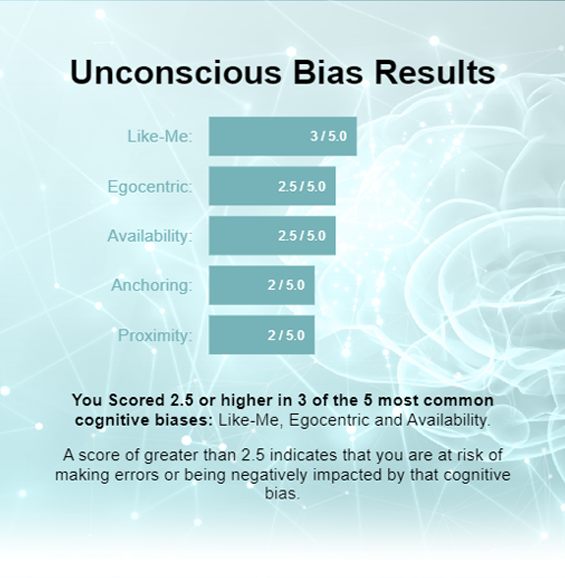As we continue to look at the five most common cognitive biases in the workplace, let’s start with a brief refresher. When we think of bias, we are most often thinking of conscious bias, an intentional act in favor of, or against, one thing, person, idea or group compared with another, usually in a way that’s considered to be unfair or unjustified. Unconscious bias is an unrecognized mental process or categorization that is intimately tied to how the human brain processes information. These unconscious, or cognitive biases, are design features of our brain that can become design flaws when we are unaware of them and how they operate.
Even though these cognitive biases are universal, they are not neutral. They can easily lead to social biases in how we interact with each other, and can be the seeds of negative institutional biases. Understanding cognitive biases provides us with tools to identify our patterns and our role in perpetuating them.
In the workplace, the most common of the five common cognitive biases is Availability Bias. It’s actually a heuristic but I intentionally categorize it as a bias to teach the concept. In its simplest explanation, this bias occurs when we make decisions based on easy or incomplete ideas, which we do more often than we realize.
The brain receives lots of information at any one time–up to 11 million bits of information each second. However, we can only consciously process about 50 bits of information at a time. That means the brain constantly looks for ways to automate as much decision-making as possible. And that’s where Availability Bias comes in. It’s a necessary function to process the volume of information, but it can also create significant problems in our decision-making. In the workplace, these problems can impact hiring, assignment of tasks, strategic thinking and ultimately, the bottom line of the company.
When we make decisions based on the easiest accessible information, in many cases, we default to whatever is the most recent information. But we can also default to information that is the most emotionally resonant or the most traumatic. Whatever memory has left the biggest impression on us will be the easiest to access and will be where Availability Bias will take us. Often this process is outside of our conscious awareness. Our conscious mind is only filling in a preconceived idea. Or justifying a pre-existing belief.
Availability Bias increases when we hurry or experience a high cognitive load. We mentally take the path of least resistance and are, therefore, more susceptible to unintentional errors. When we have to make quick, time-sensitive decisions, especially if we are already in a fast-paced or otherwise stressful environment, Availability Bias becomes even more present. This situation probably describes many of our work cultures, especially when we are increasingly asked to be “on” during off-hours or to respond quickly to something in a text or email.
Think about how Availability Bias might be showing up in an office environment. Maybe it’s through Confirmation Bias, where we only seek evidence that confirms our preconceived ideas or beliefs. This evidence could be articles, news sources, or people. When we only consult sources that are similar to our current beliefs, we mistakenly believe that everyone agrees with our idea. In the workplace, when we seek the advice of like-minded people, we activate our Availability Bias. Taking the time to consult multiple opinions, or going directly to someone who thinks differently will not only give us contrasting information and ideas, but simply taking the time to consult other people will slow down our decision-making process so that we cannot make an automatic decision.
Or maybe we are prone to the Halo Effect, where real or perceived positive attributes in one area influence our overall perception of that individual.The Halo Effect can result in decisions such as “they are an excellent engineer, let’s put them in charge of the team” without regard for whether their skills as an engineer translate to skills and abilities in leadership and personnel management. The Halo Effect can be even more insidious when perceived positive attributes come into play. The average leader in the Fortune 500 is over 6 feet. US Presidents are also of above average height. We overvalue tall people as leaders, making a subconscious connection between height and leadership abilities, when the two are not related. We might see someone and think “they look like a leader” without consciously taking time to unpack the racial, gender, age, class or cultural assumptions that go into who we have been taught “looks like a leader” and who does not.
Whatever form it takes, it is a safe assumption that Availability Bias is appearing in our work lives in some manner. And while we may all agree that we are more prone to make mistakes when we decide quickly, it is much harder to recognize this tendency in the moment and change our actions. Mitigating Availability Bias requires us to “take action” by going more slowly. We must consciously try to shift our brain into the mode that processes 50 bits of information instead of 10 million. We can prime our brain to begin to shift gears by the simple task of stopping for a minute. Perhaps moving to a new area of the office. Or putting the decision in our mind while we get a cup of coffee. All of these simple “slowing down” tasks indicate to our brain to get off autopilot for a moment.
Once we have primed our brain that we want to make a conscious thoughtful decision, then we can take steps that directly mitigate Availability Bias. We can consult someone with a different viewpoint or different way of thinking from our own and ask for their read on a situation. We can take time to gather more information than what immediately jumps to mind. We can ask others to deliberately question our own assumptions in order to land on a more measured, thought-out decision. All of these are small individual changes that will work against Availability Bias, resulting in better decisions in the workplace, especially around issues of hiring, promotion or job assignments.
As we become more skilled at recognizing Availability Bias, an important next step is to look thoughtfully at the processes, policies or informal company practices that foster Availability Bias and to intentionally change those processes so that the company culture is primed for stronger decision making.

If you have a brain, you have bias!
This 20-question test provides actionable insights. Select the response that closely matches your current state of mind. The design is intended to introduce you to the five most common cognitive biases: Like-me, Egocentric, Availability, Anchoring & Proximity. Results may vary. No data is shared with anyone.

Percipio Company is led by Matthew Cahill. His deep expertise in cognitive, social, and workplace biases is rooted in the belief that if you have a brain, you have bias®. He works with executives to reduce mental mistakes, strengthen workplace relationships & disrupt existing bias within current HR processes, meeting protocols and corporate policies. Matthew has demonstrated success with large clients like LinkedIn, Salesforce and dozens of small to mid-size companies looking to create more inclusive workplaces, work smarter, generate more revenue and move from bias to belonging®.






